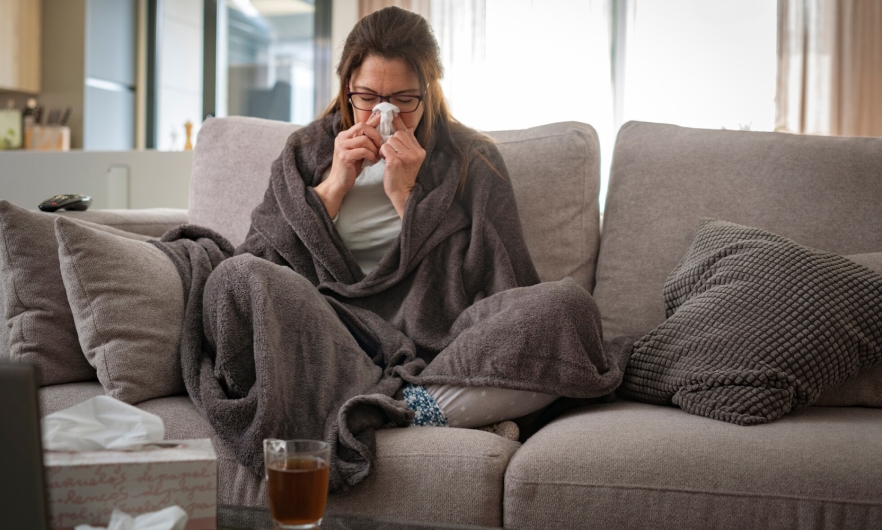COVID Rebound Can Happen Whether or Not You Take Paxlovid
How our bodies respond to viral infections is “not a smooth curve”

What initially was referred to as “Paxlovid rebound”—a return of COVID symptoms or test positivity after starting a course of the antiviral—is now more accurately referred to as “COVID rebound,” because rebound can happen regardless of whether someone takes antivirals.
What’s more, it’s likely not a phenomenon unique to COVID, says virologist Andy Pekosz, PhD, a professor in Molecular Microbiology and Immunology. What is unique to COVID is the technology—specifically rapid antigen tests—that allows us to track the progress of an infection so closely.
Researchers are continuing to investigate why some people experience COVID rebound, whether people are contagious during this period, and the role antivirals like Paxlovid might play. But one thing is certain, says Amesh Adalja, MD, a senior scholar at the Johns Hopkins Center for Health Security who specializes in infectious diseases and pandemic preparedness: The possibility that someone might experience mild rebound symptoms should not deter them from taking Paxlovid if they are at a higher risk for severe illness.
What is COVID rebound?
COVID rebound is “typically described as a recurrence of signs or symptoms or a new positive viral test result after initial recovery from COVID-19,” according to the CDC. The order of events generally looks like this: A person is infected with and has symptoms of COVID; their symptoms subside over the course of the infection, and they test negative for COVID on a home antigen test; their symptoms return, and they may test positive again on a home antigen test.
Rebound symptoms are generally mild, and no hospitalizations or deaths have occurred as a result of rebound, according to a December 2023 CDC report.
Why do some people experience COVID rebound?
Researchers are still working to understand why rebound happens and how it varies from person to person—with some experiencing a return of symptoms and others only seeing evidence through antigen testing. But at a molecular level, the fact that rebound occurs is not surprising, says Andy Pekosz.
“We think about an infection as starting as nothing, going up to a peak, and then going away, but in reality, your body is much more complicated than that,” he says. Using more sensitive tools, virologists have seen that the amount of virus present in someone with COVID goes up and down over the course of an infection, causing different degrees of symptoms.
Does Paxlovid cause rebound symptoms?
A CDC review of COVID rebound studies found “no consistent association between treatment and rebound.” Paxlovid does not directly cause symptoms to return; in fact, only about 1 in 5 people who take Paxlovid experience rebound, and many of those are asymptomatic.
“Paxlovid is taken daily for five days, and it’s possible that the immune response is somewhat blunted during that period. The hypothesis is that after those five days, the drug pressure from Paxlovid is gone and whatever remnants of the virus are still present are able to cause symptoms again,” Adalja says. “We don’t quite understand why it happens in some people and not others, but it likely has to do with the nuance of the immune response and how that's impacted by antivirals.”
The risk of rebound should not preclude someone who's at high risk or severe disease from taking Paxlovid, and it definitely shouldn’t preclude doctors from prescribing it. “Taking Paxlovid clearly reduces the likelihood of an individual developing severe COVID, irrespective of COVID rebound,” Pekosz emphasizes.
Can COVID rebound happen to people who don’t take Paxlovid?
Yes. In fall 2020 and spring 2021—before Paxlovid became available—Pekosz and other virologists studied how infectiousness and viral load varied among individuals over the course of a COVID infection. Their results showed numerous instances of what we now describe as COVID rebound: a return of symptoms or positive antigen test.
These results weren’t unexpected, according to Pekosz. “Many of us virologists assumed [rebound] was happening because we understand that these viruses come and go, they're not smooth curves in terms of your responses,” he says.
Is a person contagious while they have rebound symptoms?
Possibly—but Adalja explains that contagiousness is better determined by test positivity than symptoms. “If a person experiences rebound symptoms but doesn’t test positive on a home antigen test, they likely aren’t shedding enough virus to be infectious,” he says. “However, if they test positive on a home antigen test, that does likely correlate with contagiousness.”
When someone tests positive on a home antigen test, does the darkness of the test line correlate to contagiousness?
A faint line on a home antigen test is still a positive test result. “The tests are validated to tell you yes or no” to whether it detects viral material, Pekosz explains, not how contagious you are. “A dark line does mean more viral load,” he says, but there’s no system that correlates different shades of red with level of contagiousness.
“If you're testing positive following a previous negative test or following a full course of Paxlovid, that's where masking and distancing becomes important,” Pekosz says. “But again, only at the tail end of an infection, when you’re feeling better and symptoms aren’t severe.”
Does rebound happen with other viruses, like flu and RSV?
It’s likely that rebound occurs with other viral infections, Pekosz explains. “It probably happens with influenza, but we don't have the at-home tests to capture that,” Pekosz says, adding that he hopes future availability of at-home flu tests will allow virologists to analyze flu cases like they have with COVID.
“What we can do in terms of diagnosing ourselves with COVID and following the course of the disease is light-years ahead of what we can do for influenza,” Pekosz says. “It’s a testament to the fact that we've done good science and gotten these tools in place to see these kinds of variations that we've never been able to see with other viruses or infections.”
Aliza Rosen is a digital content strategist in the Office of External Affairs at the Johns Hopkins Bloomberg School of Public Health.
RELATED:
More from the Bloomberg School
- See latest headlines
- Learn more about our departments:





